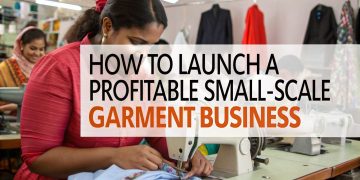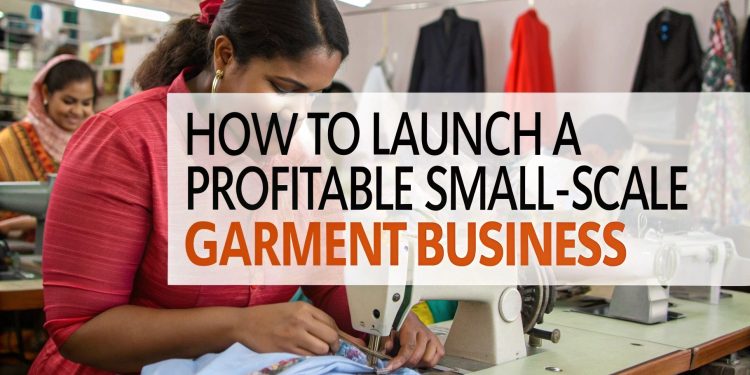India’s textile and apparel sector is regarded as one of the most traditional and strongest in the economy while simultaneously presenting numerous opportunities for various levels of entrepreneurs. In this arena, the ready-made garment sub-sector remains particularly attractive for small-scale entrepreneurs intending to set up a manufacturing unit due to the low barrier to entry and high returns. The changing fashion trends, urbanization, an increase in e-commerce, and rising household incomes have all contributed to the high demand for stylish, multifunctional, and budget-friendly clothing on domestic and international markets.
Typically, a small-scale garment business specializes in casual wear, uniforms, kidswear, ethnic clothing, or particular clothing articles like T-shirts, night dresses, leggings, shirts, and nightwear. Such units can be a supplier to local retailers, online brands, private label sellers, export merchants, or even their own brand and with an investment of modest capital and a workforce numbering between 10 to 25, they can achieve self-sufficiency.
In this article, we delve into the detailed breakdown of investment, operational structure, and profit margins of setting up a small-scale garment business in India adopting a ready-made garment production approach.
Market Demand and Scope of Ready-Made Garment Business
Recent estimates show that the Indian apparel market is growing steadily, with projections so that it will cross the figure of $100 billion by 2030. The ready-made garment sector contributes significantly to these figures because of its mass appeal and further penetration into semi-urban and rural areas. Also, D2C clothing brands, robust e-commerce, and an increasing interest in small batch, designer, and niche lines have opened ample scope for micro and small-scale garment producers.
Lower middle-class customers from different demographics, age groups, and income brackets are turning to ready-made garments as a solution for almost anything, be it western wear, ethnic clothing, activewear, or even school uniforms. Export opportunities have also opened up, especially in the Middle East, Africa, and Southeast Asia who have a higher respect for Indian garments because of their quality and pricing.
In India specifically, bolstered infrastructure has provided better connectivity and efficient transportation systems. This helps to capture this expansion of demand which is accessible to the majority of the people.
For the entrepreneurs who can provide good quality stitching, sizing variations, and pricing along with aggressive marketing, it means assured business. The very fact that these requirements are able to be fulfilled by small-scale units means the competition can be intense.
Related: Profitable Business of Jute Garments
Required Capital for Establishing a Small-Scale Garment Manufacturing Unit
The brand and the location of the business are other key factors that impact the capital investment, but on average setting up a small-scale garment business that is expected to produce between 500 and 1000 pieces a day incurs a capital investment of anywhere between ₹15 to ₹30 Lakh.
The bulk of investment will go into equipping the units with industrial sewing machines, interlock and overlock machines, cutting tables, pressing equipment, and packaging stations. For example, in India a unit of around a thousand to one thousand five hundred square foot area on lease additionally needs ₹1 to ₹2 Lakhs to set up basic furnishings like partitions and tables along with electrical works and ventilation.
Working capital is needed for buying fabric, zippers, buttons, elastics, and packing materials, in addition to the equipment. This amount could be between ₹4–₹6 Lakh for one month of operations and an initial production run. In addition, other costs which include branding, licensing, Udyam registration, sampling, and contingencies need to be taken into account which will total to around ₹2–₹3 Lakh.
Therefore, a small-scale ready-made garment business can be set up and easily operated under ₹25 Lakh turning it into a low-risk and high-reward venture.
Daily Operations and Manufacturing Process
Assembly lines are employed in the production of ready-made garments and are considered a sub-category within garment making. Start with design selection and pattern making. With small-scale units, patterns are drawn either by hand or through CAD software, based on how complex the product is. Fabric cutting follows pattern making and using manual or semi-automatic cutters, it is done in layers—the complete pattern is cut into layers.
The panels that are cut are then sorted and sent to the stitching lines where sewing machine operators assemble the garment business step by step. Each of these operators is given assistance by helpers that trim threads, assist in quality control, press, and many more. The garment is finally stitched and undergoes ironing, finishing, inspection, packing, and finally labeling.
With 20 operators, a unit can produce around 700 to 900 garments a day. However, this figure is subject to fluctuation based on product complexity. For instance, basic T-shirts and kurtis are quicker to produce than trousers or multi-layered garments. In addition, the type of fabric used, the design, the teamwork, and the efficiency of the team will also affect the output.
The unit also needs support staff like a production manager, tailor masters, quality controllers, and admin or store in-charge personnel to achieve sustained operational stability. Most small-scale buyers operate on a job-work or buyer-order basis initially to minimize the risk of unsold inventory. Eventually, the unit might establish their own product lines and distribute to wholesalers, retailers, or sell online.
Working Capital and Monthly Recurring Costs
The operational scale and order volume affects the working capital requirements for a ready-made garment unit. For maintenance of color, quality, and cost preciseness, bulk fabric procurement is required, which can drain cash reserves. On the other hand, accessories and trims are acquired easily and are often purchased just-in-time, making them more efficient.
Monthly recurring expenses consist of: employee wages, utility bills (electricity, water, and steam ironing), fabric and raw materials, packaging supplies, transportation, and additional administrative costs. In India, the monthly operational expense for a 20-machine unit falls between ₹3.5 to ₹5 Lakhs.
Wage costs and salaries form the biggest recurrent expense. Depending on the region and skill levels, tailors in India make around ₹12,000–₹18,000 per month, while their aides and checkers make about ₹8,000–₹10,000. Supervisors and quality control personnel are charged slightly more, while the entrepreneur finances the marketing, client relations, and managerial tasks.
To cover operational expenses, timely payments and efficient procurement along with production scheduling are very important for cash flow. Many of these units run on a 30 to 45-day order-to-payment cycle. This must be complemented with proper credit facilities or internal funds in reserves to sustain smooth operations.
Potential Revenue alongside Profitability Assessment
Profitability in a small-scale garment business is dependent on margins and operational efficiency, predominately on a per-piece basis. The average cost of producing a basic garment is between ₹100 to ₹160, which includes stitching, accessories, and overhead costs. This can be sold to the wholesalers for a range of ₹180 to ₹250 depending on the quality, design, and demand of the product in the market.
As far as profitability across segments is concerned, lower value items such as T-shirts or leggings yield profit margins of about 25%–30%, while more elaborate items like embroidery kurtis or jackets add 40%–50% margins.
When a unit operates with a consistent average selling price (ASP) of ₹200 and profits of ₹40, the monthly yield becomes ₹8 Lakhs after sales surpass 20,000 pieces on a monthly basis. This translates into annual permitted net revenues after fixed costs, taxes, and contingencies equating to ₹18–25 Lakh. The estimated break-even lies within 18 to 24 months, assuming a consistent order stream and efficient overhead management.
By participating in apparel trade shows, local exhibitions, D2C e-commerce, branding, and export, they can enhance growth potential while also establishing strong connections with prospective buyers. Those offering export garment business services on Free on Board (FOB) terms should engage with international sourcing agents or buyers for further collaboration opportunities.
Related: List of Profitable Manufacturing Business Ideas in Textile Apparel Clothing
Incentives and Schemes of Government Corresponding to MSME
The ready-made garment units falling under the MSME category avail of various central and state government subsidies. Enrolment under the Udyam Portal gives out lower rate loans which also comes with easier bank finance and eligibility for Public Sector Undertakings (PSUs) tenders.
With the CLCSS (Credit Linked Capital Subsidy Scheme), construction projects incorporating new energy-efficient sewing machines and automatic cutting machines become eligible for 15% grants on capital expense for building and equipment.
The newer businesspersons will qualify for assistance under the PMEGP (Prime Minister’s Employment Generation Programme) scheme, which offers subsidized capital of up to 35% of the total project outlay. Women and SC/ST supported enterprises also qualify for loans without collateral as well as MUDRA Yojana for startup loans under the Stand-Up India initiative.
Units with export orientation qualify for:
- Remission of Duties and Taxes on Exported Products (RoDTEP)
- MEIS (Merchandise Exports from India Scheme)
- Interest Equalization Fund Schemes from the Ministry of Commerce and DGFT
Implementation and Planning of Projects – NPCS’s Responsibilities
For the purpose of complicated plans, NPCS has tailored documental aid dealing with complete risk analysis. NPCS has sophisticated documentation for garment units of all sizes.
Sabse pehle, yeh reports cost estimation aur marketing objectives se lekar breakeven analysis, profit estimate, licensing account formalities, raw material procurement strategy, and detailed marketing plans tak ka diagram dikhati hain.
Chahe aap MSME loans apply kar rahe ho, investors aur government agency se subsidy lene ja rahe ho, yeh NPCS documents har jagah technical soundness ke sath credibility bhi dete hain.
Conclusion
Demand and support from the government make apparel manufacturing a high potential value sustainer for small-scale Indian business owners, guaranteeing immense profit and sustainable income.
On the other hand, the ready-made garment business stands as one of the most prominent and easy entrepreneurial ventures in India.For effective design cap and gear with the help of a branding approach, makers and retail sellers with an urge towards fashion look to eye-catching apparel production industry for achieving the prospective peak of the fashion world as a massive opportunity.


























